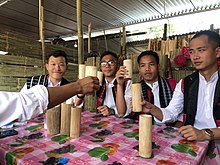
Back মিচিমি জনগোষ্ঠী Assamese Dengpes Catalan Mishmi French मिश्मी लोग Hindi Mishmi Italian മിഷ്മി Malayalam मिश्मी जनजाती Marathi Mishmis Portuguese Мишми (народ) Russian ᱢᱤᱥᱢᱤ ᱦᱚᱲ SAT
 Mishmi celebrating a festival | |
| Total population | |
|---|---|
| 35,000 approx[1] | |
| Regions with significant populations | |
| N/A | |
| Arunachal Pradesh | N/A |
| N/A | |
| Tibet Autonomous Region | N/A |
| Languages | |
| Northern Mishmi languages, Southern Mishmi languages, Mandarin | |
| Religion | |
| Animism[2] | |
| Related ethnic groups | |
| Tibetans, Other Sino-Tibetan people | |
| Mishmi people | |||||||
|---|---|---|---|---|---|---|---|
| Chinese | 代巴玫 | ||||||
| |||||||
| Deng Ren | |||||||
| Traditional Chinese | 僜人 | ||||||
| |||||||
The Mishmi people are an ethnic group of Tibet and Arunachal Pradesh, India. The area is known as the Mishmi Hills.[3] Only one group, called the Deng, occupy Zayu County in southern Tibet.[3]
The Mishmi-Idu believes that Rukmini-Chief Consort of Lord Krishna belonged to their tribe. Most of these are considered to be a fabrication. Historians point to the creation of these myths during the propagation of the eksarana-namadharma in the 16th century by Srimanta Sankardev around Sadiya, which influenced the regional identity of the place.[4] The Mishmis began to identity with the legendary Vaishnava characters created during this period which led to the formation of an alternate identity.[5]
- ^ Britannica, The Editors of Encyclopaedia. "Mishmi". Encyclopedia Britannica, 13 Aug. 2015, https://www.britannica.com/topic/Mishmi. Accessed 4 April 2021.
- ^ "(T)he Mishmi as it is connected to their animist religion and tradition"(Mayilvaganan, Bej & Khatoon 2020:108)
- ^ a b Aiyadurai A., & Lee C. S. (2018). "Living on the Sino-Indian Border: The Story of the Mishmis in Arunachal Pradesh, Northeast India". Asian Ethnology. 76 (2): 367–378 – via Ebsco.
- ^ "Among many works of Śankaradeva, the Rukmiṇīharaṇa, the poem of Rukmiṇī and Kṛṣṇa, gained considerable popularity in the Sadiya area and influenced its regional identity connstruction. Rukmiṇī, in this poem, was a daughter of king Bhīṣmaka"(Shin 2020:55)
- ^ "Considering the wide popularity of the Rukmiṇīharaṇa among the people, especially as the staged performance, it is not surprising that many toponyms of the area were derived from this Vaiṣṇava legend and the legendary places associated with Bhīṣmaka were reproduced in the local landscape.....Some tribal groups like the Idu Mishmis of the Dibang valley began to link themselves more explicitly with the legendary Vaiṣṇava figure, and this practice led to conscious identity construction."(Shin 2020:57)